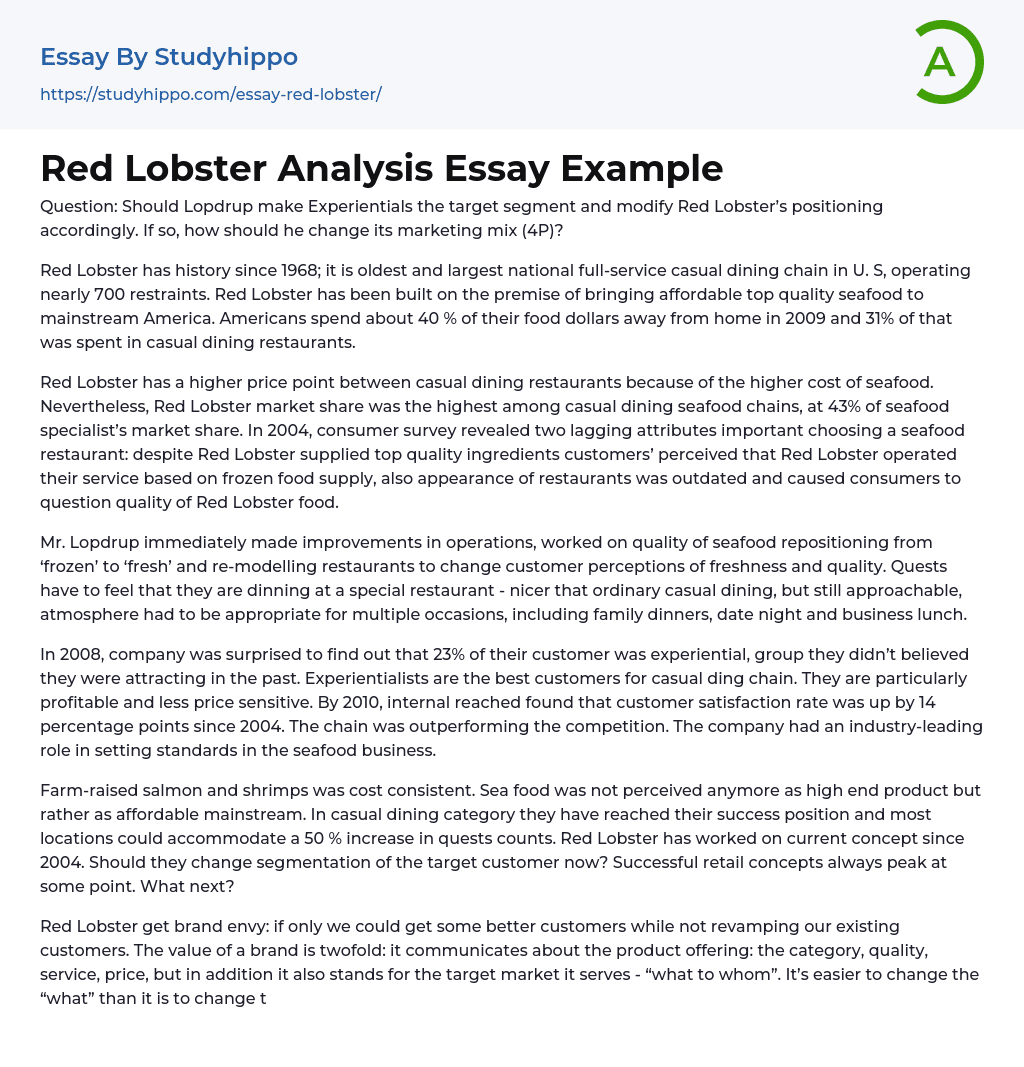Question: Should Lopdrup make Experientials the target segment and modify Red Lobster’s positioning accordingly. If so, how should he change its marketing mix (4P)?
Red Lobster has history since 1968; it is oldest and largest national full-service casual dining chain in U. S, operating nearly 700 restraints. Red Lobster has been built on the premise of bringing affordable top quality seafood to mainstream America. Americans spend about 40 % of their food dollars away from home in 2009 and 31% of that was spent in casual dining restaurants.
Red Lobster has a higher price point between casual dining restaurants because of the higher cost of seafood. Nevertheless, Red Lobster market share was the highest among casual dining seafood chains, at 43% of seafood specialist’s market share. In 2004, consumer survey revealed two lagging attributes important choosing a se
...afood restaurant: despite Red Lobster supplied top quality ingredients customers’ perceived that Red Lobster operated their service based on frozen food supply, also appearance of restaurants was outdated and caused consumers to question quality of Red Lobster food.
Mr. Lopdrup immediately made improvements in operations, worked on quality of seafood repositioning from ‘frozen’ to ‘fresh’ and re-modelling restaurants to change customer perceptions of freshness and quality. Quests have to feel that they are dinning at a special restaurant - nicer that ordinary casual dining, but still approachable, atmosphere had to be appropriate for multiple occasions, including family dinners, date night and business lunch.
In 2008, company was surprised to find out that 23% of their customer was experiential, group they didn’t believed they were attracting in the past. Experientialists are the bes
customers for casual ding chain. They are particularly profitable and less price sensitive. By 2010, internal reached found that customer satisfaction rate was up by 14 percentage points since 2004. The chain was outperforming the competition. The company had an industry-leading role in setting standards in the seafood business.
Farm-raised salmon and shrimps was cost consistent. Sea food was not perceived anymore as high end product but rather as affordable mainstream. In casual dining category they have reached their success position and most locations could accommodate a 50 % increase in quests counts. Red Lobster has worked on current concept since 2004. Should they change segmentation of the target customer now? Successful retail concepts always peak at some point. What next?
Red Lobster get brand envy: if only we could get some better customers while not revamping our existing customers. The value of a brand is twofold: it communicates about the product offering: the category, quality, service, price, but in addition it also stands for the target market it serves - “what to whom”. It’s easier to change the “what” than it is to change the “whom”. Re-modelling the stores, changing the prices, advertising, all it takes is money and commitment.
But the point of a brand is to create an image in the minds of consumers of what you stand for. To change it is to throw it away. In my opinion, Red Lobster shouldn’t change target segment and modify positioning focusing on experientials stealing share from premium casual chain. Instead they need to think how to serve existing customers with increased profitability. Step two is to ask if there is
a way to attract the more profitable customers without alienating the existing ones. If it is not possible, maybe they need a new brand, not a stretched one.
- Wal-Mart essays
- Discover essays
- Brand Equity essays
- Branding essays
- Nike, Inc. essays
- Market share essays
- Razor essays
- Anatomy and Physiology essays
- Addiction essays
- Biodegradation essays
- Dental Care essays
- Disease essays
- Disorders essays
- Health Care essays
- Intelligence Quotient essays
- Nutrition essays
- Olfaction essays
- Public Health essays
- Women's Health essays
- World health organization essays
- Cancer essays
- Infectious Disease essays
- Lung Cancer essays
- Neurology essays
- Physical Exercise essays
- Medicine essays
- Sex essays
- Inquiry essays
- Disability essays
- Poison essays
- Action Potential essays
- Nervous System essays
- Childbirth essays
- Puberty essays
- Blood essays
- Kidney essays
- Neuron essays
- Body essays
- Glucose essays
- Sense essays
- Heart essays
- Skeleton essays
- Human Physiology essays
- Eye essays
- Immune System essays
- Muscle essays
- Skin essays
- Brain essays
- Central Nervous System essays
- Human Skin Color essays




